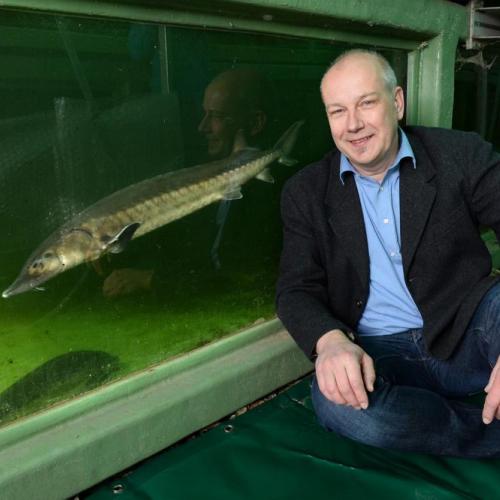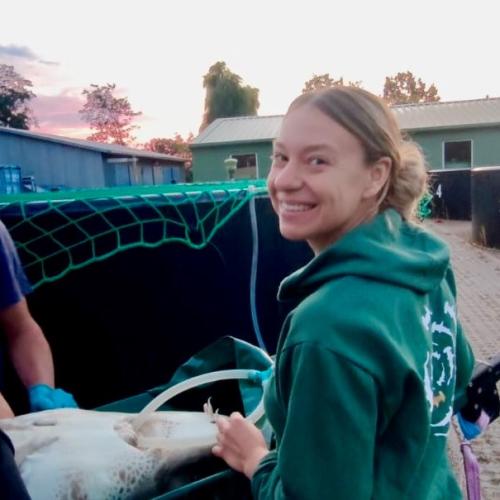HaffStör
Short profile
Duration

Stocking of marked Baltic Sturgeon ©Jacobia Dahm
According to the International Union for Conservation of Nature (IUCN), sturgeons are among the most endangered species globally. In Germany, they are considered extinct or missing. Since 1994, several institutions have been working to reintroduce these animals to their native habitats. The Leibniz Institute of Freshwater Ecology and Inland Fisheries (IGB) in Berlin has been involved in these projects for 30 years. Since 2007, juvenile Baltic sturgeons have been released annually into the Oder River as part of a reintroduction project. From there, the fish migrate to the Baltic Sea, only returning many years later to spawn in the river. But how many young sturgeons survive this migration, and what dangers do they face along the way?
The Project
The project titled "HaffStör," which started on May 1, 2024, is conducted by a research group from the Leibniz Institute of Freshwater Ecology and Inland Fisheries and funded by the Federal Agency for Nature Conservation (BfN) with resources from the Federal Ministry for the Environment (BMUV) for the next three years. In close collaboration with the State Research Institute for Agriculture and Fisheries MV (LFA), the West Pomeranian University of Technology, local fisheries, the Polish Anglers Association PZW Szczecin, and German and Polish environmental organizations, the goal of reintroducing sturgeons to the North and Baltic Sea catchment areas is intensively pursued.
The aim of the IGB’s "HaffStör" project is to investigate the habitat use of Baltic sturgeons in the Szczecin Lagoon and the Lower Oder and to determine the factors influencing their survival during migration. The project is based on the release of juvenile Baltic sturgeons to promote the population. Additionally, reintroduction efforts are to be supported with a solid data basis through targeted monitoring of the population. The migrations, habitat use, and survival rates of the sturgeons will be determined using telemetry studies, supplemented by reports from local fishermen on catches and growth information.
Many young sturgeons do not seem to survive the migration to the Baltic Sea
Low reporting rates of released sturgeons in the waters of the Pomeranian Bay and the western Baltic Sea indicate that many fish do not survive the passage through the inner coastal waters of the Oder estuary. Despite extensive stocking measures in the Oder, bycatch reports from fishermen in the coastal waters remain very low. The low numbers are not due to a "reporting fatigue" among marine fisheries, as there is a significant increase in the frequency of reported catches of marked sturgeons after stocking measures near the coast. Reports from the Lower Oder Valley have also been proportional to the number of stocked fish. Therefore, the low reporting frequency in coastal waters suggests a high mortality rate of the stocked fish in areas such as Lake Dąbie, the Port of Szczecin, and the Szczecin Lagoon, which could be due to various influencing factors.
Clearly identifying the causes of this mortality is crucial to take targeted measures to protect the animals. This is where the new HaffStör project comes in: it aims to establish scientific foundations for adaptive management in both stocking planning and water management.
Better tracking of population development and adaptive management
In the course of the investigations, the migrations, residency probabilities, and survival rates of the sturgeons will be determined using telemetry studies. Accompanying studies are expected to provide specific data on the spatial and temporal use of fishing techniques in the region. These data sets and catch reports will be used to determine migration routes and gain a better understanding of influencing factors, such as the role of water construction measures, fishing, and predation pressure on the decline of sturgeons. The establishment of monitoring of population development coordinated with Polish partners is a key step in improving the data basis for adaptive management, as required by the HELCOM Action Plan. Understanding the factors influencing the survival of the animals is also crucial to develop targeted measures to mitigate them.
This is particularly urgent in the face of new threats to the fish populations in the Oder, such as the bloom of the toxic brackish water alga Prymnesium parvum, habitat loss due to the expansion of the Oder, and the construction of new weirs and hydroelectric plants. Only through adapted management can the resilience, i.e., the natural resistance of the river system and its organisms, be increased.
Reintroduction efforts continue
The project’s work is based on the release of juvenile Baltic sturgeons to further support the population. The juveniles are raised in a container system with Oder water once they can feed independently. This rearing in the immediate catchment area ensures high adaptation to and imprinting on the home water, significantly improving the fitness of the stocked fish. About 25,000 juvenile sturgeons are expected to be released into the Oder annually as part of the project.
Nationales Artenhilfsprogramm des BfN mit Mitteln des BMUV





